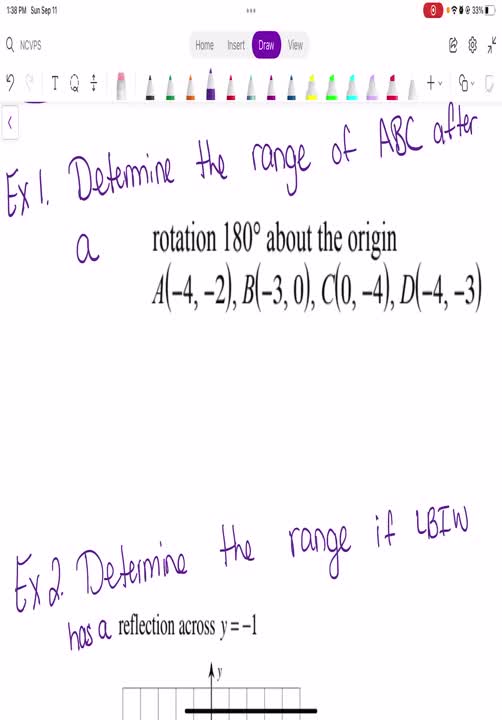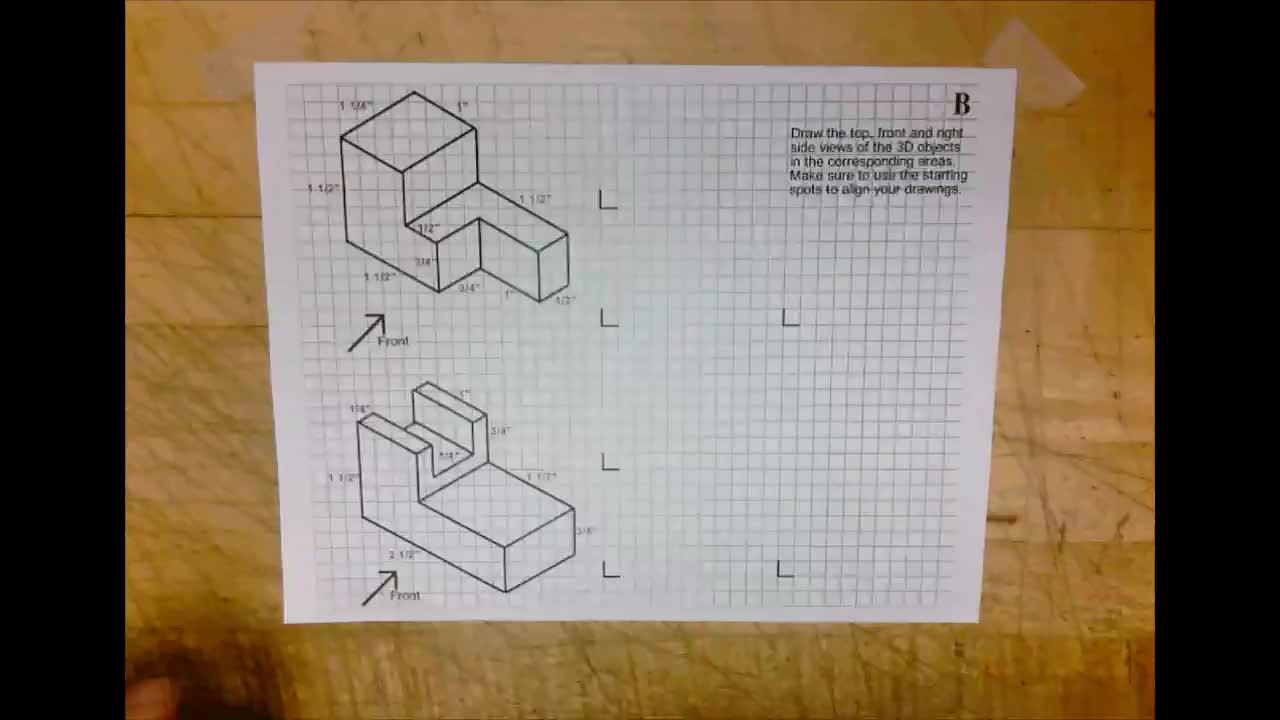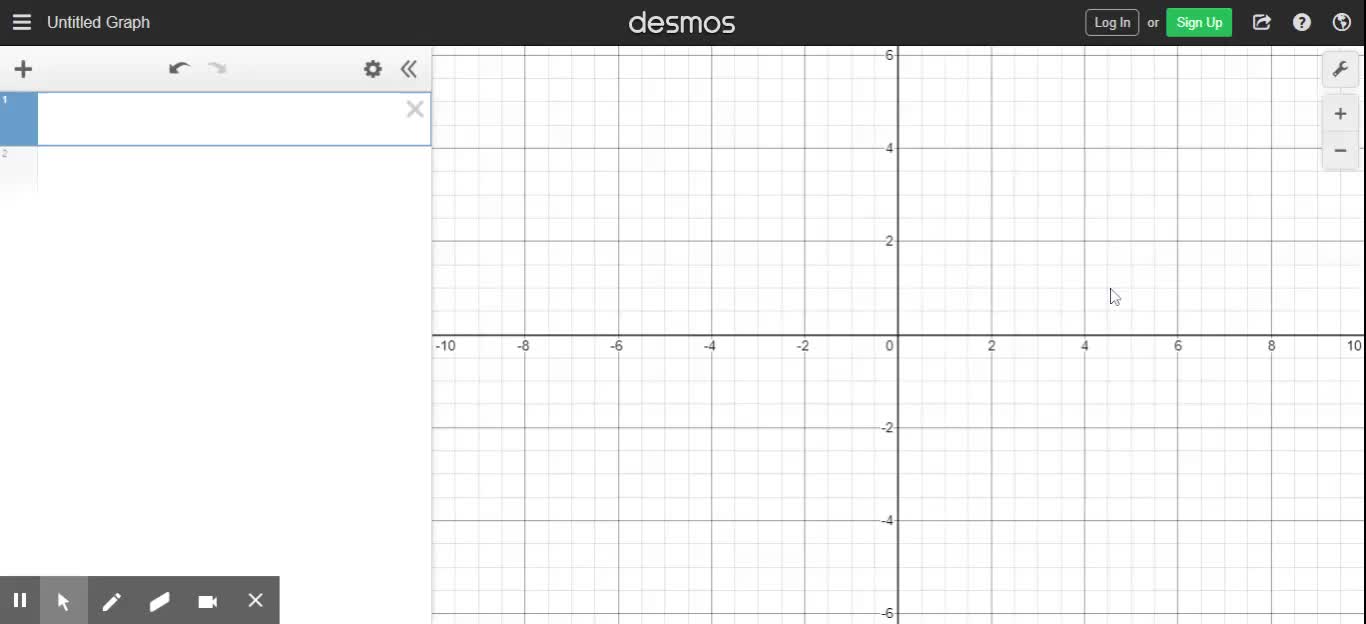Geometry Unit 8 Lesson 4 - Using Trig to Solve for Angles
High School / Math / Geometry
Hi everybody, mister Wagner here to take you through lesson four in our trach unit okay today we're going to be talking about finding angles in a right triangle. All right, if you recall before this previously, we've used our SOHCAHTOA and our three trade functions sine cosine and tangent to find a missing side length of a right triangle. Today we're going to use them to actually find the measure of an angle. So let's get started. Exercise one says given the right triangle shown. Set up a trigonometric ratio involving angle a now remember what we talked about in class what angle you're looking at is super important, right? That's going to dictate where your opposite side is where you're adjacent side is, and that's going to allow you to pick the proper trig function to use. All right, so as always, we usually label the triangle as opposite adjacent and hypotenuse to give us a good idea of what we want to use. So if angle a is the angle we're looking at, that's going to make 17 the adjacent side. That's going to make CB the opposite side and that's going to make AC the hypotenuse, right? AC is the hypotenuse no matter what, because that's a cross from the right angle. But opposite and adjacent are going to change. So if I have side lengths with the adjacent and the hypotenuse, well, cosine is the trade function that relates adjacent to hypotenuse. So I'm going to want to use cosine of angle a, so we don't know what angle a is, but that's all right. We're just setting up a ratio. Equals adjacent over hypotenuse at 17 over 22. And that's it. We could simplify this right as a fraction. I'm sorry, as a decimal, if we wanted to, but for right now, we'll just leave it as a fraction. So next part says, if we want to cancel out any trigonometric ratio, so look, for example, here, we don't know what angle a is, right? I don't have an actual measure for that. But we could find it, all right? In order to do that, we're going to have to use what's called an inverse trig function. Now, inverse trig functions work, you know, the way all inverse functions do, which we're going to get to in just a little bit. So let's rewrite this in the box first about inverse functions. This is the inverse of sine, so it just called inverse sine, the notation is signed to the negative first power that denotes an inverse, okay? We have inverse inverse cosine, which is cosine to the negative first of whatever you want inside there. And inverse tangent, ten to the negative first power. They all give angles as their outputs, okay? So that's important. Remember what we've talked about so far. I'm going to open up a new page here. If I just have sign of a equals whatever. Opposite over hypotenuse, right? This is a ratio of side lengths. And I said, if you remember one thing, anything inside of a regular trig function is always an angle. Okay? Well, when we're dealing with an inverse, so if I were to do sine inverse of I don't want to call it a anymore, but I'm just going to call it X, okay? Equals a why did I write it this way this time, okay? Inverse basically says do the opposite. Okay? So instead of an angle being inside my parentheses, now it's a ratio of side lengths. Instead of the ratio of silence being my output, my output is now an angle. So because your output is an angle when you use inverse trig functions, that's going to allow us to find an angle, basically. And we'll see how it works when we do some examples. All right. Going back. So as the inverse trig functions are also sometimes called arc functions. So sometimes instead of inverse sign, you might see called arcsine, or arc cosine or arc tangent. All right? So you might see it called any of those in a problem, which is fine, okay? Arc sine is inverse sine, arc cosine is inverse cosine, et cetera. All right, so let's actually try this out. All right, so use the trig ratio and exercise one to solve for angle a so it's going to be the same exact picture we used for number one, just to recap. This is angle a, we said this is adjacent. This is the hypotenuse. So we want to say that the cosine of a, again, we did not use an inverse trig function yet, right? Equals 17 over 22. So this is still an angle. Now, here's why we have to use an inverse function, right? Little aside here. If I have two times X equals ten, well, we all know that we have to divide by two, right? Well, why are we dividing guys? Because multiplication and division are inverses of one another, they cancel each other out. So what we have to do is take the inverse of this cosine, right? A is trapped inside of the cosine function. In order to get rid of it or cancel it out, we have to take the inverse of cosine. So here's the notation. It would be the cosine inverse of cosine of a, okay? So I'm taking the inverse cosine of this whole thing. Well, as always in math, whatever you do to one side you have to do the other, right? So this has to be the cosine inverse of 17 over 22. Okay? Well, look what happens. Cosine inverse and cosine cancel each other out, right? They're inverses of one another. Just like multiplication and division cancel each other out or addition and subtraction cancel each other out. So now we're just left with a remember, a is an angle, right? Which is what we want to find, right? So a is equal to the cosine inverse of 17 over 22. Again, we're really trying to understand what's going on here inside of an inverse trig function is a ratio of side lengths, right? This goes to what I said here. Okay, so our outputs and angle are input as a ratio. And that's exactly what we have in exercise number two right now. Now, in order to do this, we have to use our calculator, okay? So I'm going to show you how to do it on the regular calculators. Now you're watching this at home, so there's a good chance you might not have one, but I'm going to show you an alternative on how you can do some of the questions. So I pulled up a picture of the calculator here. So in order to use the inverse trait functions here, sine cosine tangent, see how right above them is signed to the negative first cosine to the negative firsthand to the negative first. Those are inverse functions. Hopefully by now we know that anything in blue on the calculator, we have the second before we can use it. So if I wanted to do the inverse cosine of 17 over 22, all I would do would hit second, cosine, and then inside the parentheses I type in 17 divided by 22. Close up your parentheses and hit enter. Okay? And that should give you the answer you want. Make sure you're in degree mode though, right? If you're not in degree mode, then it's not going to give you the proper answer that you're looking for. Right now, if you don't have the calculator at home next year, you can still use your computer or your phone, whatever the Internet. Okay? So there's this great website. It's called wolf ram alpha dot com. So there's a URL right there. Wolf ram alpha dot com. Okay? You can really type anything you want into this. It's an online calculator. It's really great. So if I want, I can do sign. Oh, sorry, we want cosine, right? And we want the inverse. So I'm going to hit my little carrot here. Negative one. And then inside the parentheses, I'm going to type in 17 over 22. So and it's even nice to make sure that you close up your parentheses and all that stuff. You hit enter and it's going to take a second, but it will give you an answer. So look, this has result in radians, right? We don't want that. We want degrees. So in degrees, this is about 39.4°. So there's your answer right there. So you can use this wall for M alpha for a lot of things, really anything you need. It's a great online tool. So a is about 39.4°. And there's our answer we use our inverse trade function to find a angle. Okay. Now, if you really want to in WolframAlpha, I believe that you don't even have to type in the cosine negative one. Now you should because it's good practice. You could also type in arc cosine, right? We learned that that's the same exact thing. So R cos of 17 over 22 gives you the same thing. And I think if you really wanted to, you can even just type in cosine inverse of and should really give you the same thing here, and it does. Okay? So this is a great tool. You can kind of type in if you're a little stuck with the notation, now using the notation is proper, right? It's good to know that. But if you're a little bit stuck, you can kind of get away with it on this WolframAlpha by typing things in. And then in the output, you can see what the notation is, which is awesome. Okay? So this, again, is a great towards wolf ram alpha dot com. I'll be using it kind of for the rest of the lesson here. All right, so we found our first angle using trick. All right, very similar to finding a side. We just have to use the inverse trig functions. Let's try exercise three. Given the right triangle below, determine the measure of angle E so here's the angle we want to the nearest degree. So we're going to round it to the nearest whole number. So WolframAlpha doesn't know what you want it to round to. However, you can just take whatever decimal they give you around it yourself. By using your calculator and one of the inverse trig functions, show your work and use proper notation. Okay, so we want E okay, let's look at the give us 8 is the adjacent side, 11 is a hypotenuse. So if you have a JSON and hypotenuse, it looks like we're going to use cosine again, right? From SOHCAHTOA, cosine is adjacent over hypotenuse. So it's cosine and it's always of the angle. Equals 8 over 11. Okay? Well, if we want to get rid of this cosine here, we're going to have to take the inverse. So I need cosine inverse cosine, and then you put that whole thing inside of it. Equals cosine inverse of 8 over 11. These are going to cancel each other out. And we're just left with the angle E equals cosine inverse of 8 over 11. Okay? Again, if you're going to be using your calculator, you hit second cosine to get your inverse and then 8 over 11 hit enter and round. Okay? I don't have my calculator here. It doesn't work on my computer at home. So I'm just going to use WolframAlpha. So it's going to be cosine to the negative first or inverse. Of a divided by 11. Okay, enter. And let's see what we get. This is in radians. We don't want that, right? So in degrees. 43.34. It said to the nearest degree. So it's just 43°. This is my answer. So it's about 43°. Okay. Moving on to the next one. All right, let's see what we got. We have one finding a missing angle in a right triangle. There are always two options for how to set up the problem. So let's try to use two different trade ratios using angle a and C, all right? We're going to set up two. So anyway, okay, that would make 20 the opposite and 41 the adjacent, right? So we're going to have ten of a equals 20 over 41. Well, now what if we care about angle C that now makes 41 the opposite in 20 the adjacent, right? So in this case, we have tan of C equals 41 over 20. Okay. Well, it says what must be true about angle a and angle C well, we've kind of answered this question a few times before, right? When we dealt with co functions, if this is a triangle, we know it has a 180° total, right? The right angle is taking up 90 of them. So if I were to take angle a and angle C, they have to add up to 90 to get my triangle to one 80. So angle a plus angle C must be equal to a 180. Oops. No, I'm sorry. Equal to 90°. Okay? So knowing that, we're going to find out a nice little property here. Or at least find out that it's true. Okay? B says solve each trig ratio for angle a and angle C to the nearest degree. All right, so we're going to use what we already have up top, right? So let's say tan of a that's angle a equals 20 over 41. We're going to take the tan inverse of both of these. In order to get rid of the tangent function. Okay? These are going to cancel each other. We're just left with a equals tan inverse. Of 20 over 41. I'm going to go to my online calculator. So I want ten inverse of I forgot what the numbers were. I think it was 20 over 41, yep. Of 20 over 41. We're going to round it to the nearest degree. So whatever they give me, I'm just going to round. Again, this is not the right answer. This is radians. All right, so we have 26°. So they rounded it for us here, which is nice. So let's put it in there. So 26°. Now, if what we said in part a holds true, we should know that angle C is going to be whatever 90 -26 is, right? And that's what 70 sorry, 64. We should get when we do this. Let's just be sure. So again, we're going to use this trig function. We already set up where this ratio. So ten of C is 41 over 20, take the inverse. Equals ten inverse of 41 over 20. As you guys get better at this, you don't really have to write it out every time, right? You can just kind of take the inverse here because you know that that's what you're going to have to do. But for now, it's nice to write it out. So we know exactly what's going on each time. So let's see, we get tan inverse of 41 over 20. So I can actually just switch these around in WolframAlpha. Okay, and we got 64°, which is exactly what we want. So proving that angle a plus angle C has to add up to 90. Okay, so there's our two answers. Awesome. All right. And let's see we have exercise number 5. All right, really, you should probably pause the video right now and try it yourself to make sure you can do it. So that would be a good time to do that. And I will go through it over here. So I'm going to make a nice right triangle this time. So we have a right triangle. You have to draw it if you don't draw it. There's no way you're going to be able to do it properly. PQR. They're telling me that Q is the right angle, so that has to go there, which makes this P in this R if P Q is 19. PR is 26. Draw a picture of the triangle and find the measure of angle Q to the nearest tenth. Okay, so this is actually a typo. We don't want to find the measure of angle Q, right? We know Q is the right angle. So we know it's 90°. We can go through how to do that in just a second. But let's forget angle Q let's find the measure of angle R, I apologize for that. Okay, so let's see what we got for interested in angle R that makes 19 the opposite and 26 is the hypotenuse. So if we have opposite and hypotenuse, again, on your paper somewhere, you should always have so contour written, okay? So if we want opposite and hypotenuse, that's sine. So it's going to be sine of angle R is equal to 19 over 26. I'm going to instead of writing it out like I've been doing the whole time. I'm going to take a little shortcut here. I'm just going to say R is equal to sine inverse of 19 over 26. All I did right there was skip the step of writing it out, crossing them out and rewriting. Just because it's the same thing every time. So let's put it into WolframAlpha sine inverse of 19 over 26. So sine inverse of 19 divided by 26. And that gives you about 46.95°. Let's see if they ask us to round to. Nearest tenth, okay? So it's the nearest tenth. The 5 is actually going to round it up to a zero here, which pulls us up to 47. So in total to the nearest tenth is really going to be about 47°. So it's going to be about 47. I'll put the .0 for the tenths place. Degrees. And there's our answer. Okay? So that kind of does it for the lesson. I'll do angle Q really quickly on how I would do it. They would never ask us to find this because we know it's 90°, but if they did, well, here's Q that makes this not only the hypotenuse, but the opposite side. We can't use adjacent because there's really two adjacent sides if you're talking about angle Q so we have to use sign again. Again, they don't really ever ask you to do this, but it's sine of Q equals 26 is the opposite in 26 is the hypotenuse. Well, we would do Q equals sine inverse of 26 over 26. And is it 26 over 26 is equal to one. So sine inverse of one and this should give you 90 or it will give you 90. When you put it in. And you get 90°. So it does work out, which is nice to see. David just never asked you that because it's implied that it's the right angle. Okay, so that's how you would do it there. So that does it for this lesson guys. That's how you find angles in a right triangle. Okay, remember if you would like extra practice besides those homework pages, right? So here are the pages that are the homework pages you can fill all this stuff out, right? Don't worry about this table. It's not really great. Okay, I would just jump down to number two, three. And try some of the ones on the back are really good. Okay? If you want extra practice, always look at the supplemental. All right? So I don't know exactly which page this is, but if you look at the table of contents on the front of your packet, you have all this really nice stuff that you can practice, right? Here's all these triangles, find the missing angle, okay? And yeah, that's about it. So try out some of the practice, make sure you know how to do this. And that's about it. All right, so I hope you guys are staying safe and healthy, and we will talk to you soon.

















